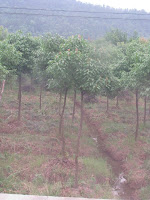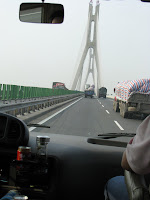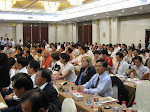 One of the places I most wanted to visit while we are in China is the Great Wall, and I was thrilled that we would have the time to fit it into our schedule. Our guides told us that average Chinese people are fascinated by the way the rest of the world is fascinated by the Great Wall. To many Chinese, the Great Wall represents bad memories of repressive leaders, from ancient time
One of the places I most wanted to visit while we are in China is the Great Wall, and I was thrilled that we would have the time to fit it into our schedule. Our guides told us that average Chinese people are fascinated by the way the rest of the world is fascinated by the Great Wall. To many Chinese, the Great Wall represents bad memories of repressive leaders, from ancient time s when being sent to work on the Wall was not only a punishment, but a virtual death sentence. To tourists like us, it is one of the Wonders of the World, an incredible achievement.
s when being sent to work on the Wall was not only a punishment, but a virtual death sentence. To tourists like us, it is one of the Wonders of the World, an incredible achievement.We visited the Badaling section of the Great Wall, the section most visited by tourists because of its proximity to Beijing, the Capital city. Badaling is approximately a one hour drive from Beijing. We climbed toward the Wall with numerous other cars and trucks on a busy highway.


There are many ways to reach the Great Wall, and our hosts recommended that we climb some steep stairs to a cable car station, then take the cable car to the base of the Wall. It sounded like a great suggestion to us, considering the time we had and our collective physical condition. It is possible to hike, bike and run up the mountain to the base of the Wall, but we had neither the time nor inclination. As you may recall, I was recovering from a broken leg that happened about 2 months before the trip. The picture on the right shows our group waiting for the next cable car, with our two escorts.
Contrary to my understanding that the top of the Great Wall was flat, there are great inclines and declines along the top of the wall. And in some places there are stairs. The pictures on the left and right illustrate my point.



Lucille is the figure with the blue shirt and light green bag in the pictures on the left and above. The figure in navy blue in the picture on the right is one of our escorts. If you are planning to visit the Great Wall, be sure to wear comfortable walking shoes.
The picture on the left below shows the four of us that walked on the Great Wall that day. Jinshui decided to stay behind and work. He told us he had visited the Wall many times with other delegations, and that we would be in good hands with our escorts. He was right.
to stay behind and work. He told us he had visited the Wall many times with other delegations, and that we would be in good hands with our escorts. He was right.
Contrary to my understanding that the top of the Great Wall was flat, there are great inclines and declines along the top of the wall. And in some places there are stairs. The pictures on the left and right illustrate my point.



Lucille is the figure with the blue shirt and light green bag in the pictures on the left and above. The figure in navy blue in the picture on the right is one of our escorts. If you are planning to visit the Great Wall, be sure to wear comfortable walking shoes.
The picture on the left below shows the four of us that walked on the Great Wall that day. Jinshui decided
 to stay behind and work. He told us he had visited the Wall many times with other delegations, and that we would be in good hands with our escorts. He was right.
to stay behind and work. He told us he had visited the Wall many times with other delegations, and that we would be in good hands with our escorts. He was right.







 There were vendors selling everything from embroidered paintings to clay figurines to silk scarves and carved wood items. I found a lovely cane with a dragon head and flowers carved along its length. Lucille, who is posing in the picture on the right, found a lovely traditional teapot and a couple of chess sets for family members. John and Mark made similar discoveries in some of the small shops along the street. We only had time to visit about a quarter of the shops in the old town; we could have spent an entire day there. I was taken with some of the tea carts spaced strategically along the way, a few of which had lovely dragon tea pots.
There were vendors selling everything from embroidered paintings to clay figurines to silk scarves and carved wood items. I found a lovely cane with a dragon head and flowers carved along its length. Lucille, who is posing in the picture on the right, found a lovely traditional teapot and a couple of chess sets for family members. John and Mark made similar discoveries in some of the small shops along the street. We only had time to visit about a quarter of the shops in the old town; we could have spent an entire day there. I was taken with some of the tea carts spaced strategically along the way, a few of which had lovely dragon tea pots.



 Partway through the meal, a chef rolled a cart into our room and showed us first-hand how to make dumplings. It was a memorable meal, and we
Partway through the meal, a chef rolled a cart into our room and showed us first-hand how to make dumplings. It was a memorable meal, and we 
 The table in the restaurant was a good demonstration of the use of napkins to show where the most important people at the table should sit. Look at the napkins in the picture below.
The table in the restaurant was a good demonstration of the use of napkins to show where the most important people at the table should sit. Look at the napkins in the picture below. 






 Tianjin is a big city -with a port, big city landscapes, skyscrapers, monuments, billboards, narrow side streets, loads of small storefronts - and an estimated 11 million people (at the end of 2007). Tianjin is just a 90 minute drive from Beijing, depending on traffic. Soon there will be an even more convenient way to travel between the two cities. In July, about a month after our visit the central government will launch high speed train service to link Tianjin to Beijing, just in time for the Olympics. This is confirmation the Tianjin-Binhai area is increasingly important to the national economy.
Tianjin is a big city -with a port, big city landscapes, skyscrapers, monuments, billboards, narrow side streets, loads of small storefronts - and an estimated 11 million people (at the end of 2007). Tianjin is just a 90 minute drive from Beijing, depending on traffic. Soon there will be an even more convenient way to travel between the two cities. In July, about a month after our visit the central government will launch high speed train service to link Tianjin to Beijing, just in time for the Olympics. This is confirmation the Tianjin-Binhai area is increasingly important to the national economy.












